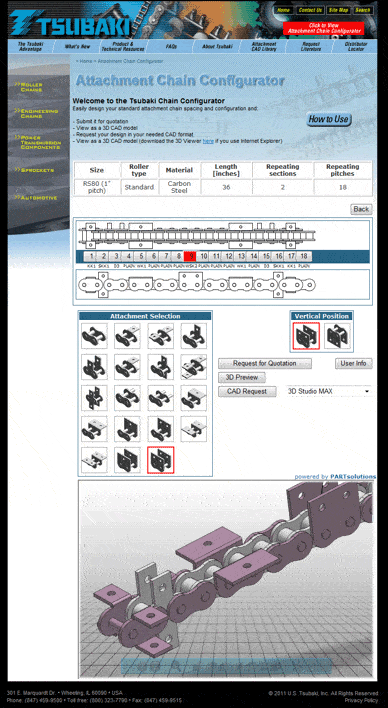EETimes Design: Tips & Trends
Operational efficiency continues to be the mantra of today’s manufacturers. Companies perpetually seek out new methods and technologies to save time, reduces costs, and enhances customer service–all while increasing lead generation.
Consequently, companies large and small are turning to CAD-native 3D product catalog technology to save time and money, enhance customer service, and increase lead generation. By enabling manufacturers to get their products selected, designed in and purchased, CAD-native 3D product catalogs are rapidly becoming a critical business component for manufacturers, with 80 percent of design engineers indicating that multiple units will be purchased for production once downloaded.
CAD-native 3D parts catalog management technology preserves 3D part catalog content independent of CAD system or version. This allows for stability in the ongoing catalog maintenance process, and gives designers the ability to find supplier approved parts quickly and with confidence, thereby reducing product development, catalog management and inventory costs.
Tsubaki ‘Rolls’ Out 3D Configurator
For instance, U.S. Tsubaki leverages an innovative 3D part catalog solution to establish quick design as one of its primary competitive advantages.
Earlier this year, the leading manufacturer and supplier of power transmission and motion control products launched the U.S. Tsubaki Attachment Chain Configurator for its Roller Chain Division. The Configurator contains many of the most common attachments used in a wide variety of conveyor and packaging applications and automates a process that has traditionally been manual and prone to errors. The digital tool not only enables engineers and designers to create custom attachment chain configurations interactively via the Internet, but also provides users with the ability to download 3D files in a variety of electronic formats and request a quotation.
Using rules-based logic to quickly configure and download high-quality product data in native CAD, the Configurator simplifies the previous time-consuming and complex manual paper process of configuring standard chains or specialty attachments. More specifically, with the web-based graphical configurator, customers and partners can take the following actions:
* Interactively design hundreds of thousands of attachment chain variants by selecting graphic representations of chain sizes (pitch), types, materials, repeating sections, and attachments.
* Preview the product interactively on screen.
* Download the product as a 2D or 3D CAD model in any of more than 100 native and neutral CAD and graphic file formats.
* Submit the configured product for quotation.
For U.S. Tsubaki, the solution is having a dramatic impact on its demand generation by allowing the company to proactively deliver sales and support information to its customers in less time. In its 90-day beta period with select customers and partners, U.S. Tsubaki is averaging 300+ configurations a month and is saving end users hours of time in configuring custom attachment chains.
Breaking the Mold
In another example, DME has been leveraging 3D part catalog technology for more than a decade. The company–an essential mold technologies resource to the plastics industry worldwide–web enabled its vast product line, which encompasses more than 66,000 items in 69 different 2D and 3D CAD and graphic formats. Today more than 80 percent of the company’s standard products are featured in the online catalog and the technology enables DME to easily maintain its library to support frequent CAD revisions.
The company’s approach is to provide all possible information to its customers–4.5 million CAD files in all–so they can make informed manufacturing decisions. An average of 6,000 DME 3D products are downloaded from DME’s CAD library each month, enabling mold designers to easily integrate DME parts into their designs. What’s more, enabling delivery in any native CAD format to support the needs of more customers, and in turn, generates more qualified sales leads.
Earlier this year DME embedded its sales configurator directly into its website, making the DME sales configurator an even more intuitive part of its customers’ product selection and design processes. Seamless integration with the company’s website, single sign-on (SSO) and corporate identity (CI) has made the process even simpler and faster for DME customers.
DME’s continued focus on delivering what its customers need–access to product CAD data without drawing it themselves–is a value-added service that makes the company both a leader and an innovator in its space.

The Numbers Don’t Lie
This is an exploding trend. In 2005 PARTsolutions delivered just over 1 million 3D catalog parts per month for manufacturers, or about 13 million per year. By 2010, 48 million 3D CAD product models – or an average of 4 million per month – were downloaded by designers and engineers across the globe from a vast number of web properties enabled by PARTsolutions’ unique technology. Not only does this number mark a 27 percent increase in downloads over 2009, it also corresponds to a substantial amount of revenue in the global economy, resulting in the sale of more than $25 billion in supplier components last year. 2011 is shaping up to be another growth year, with 5 million monthly downloads already having been achieved. Over time, design engineers will be ever more demanding about accessing high fidelity 3D product data in the format of their own design technology.
A Final Word
In today’s fast-paced and ever changing global business landscape, few activities are as important to the success of a company as being responsive to customers. When you can implement a technology that not only meets their needs, but also improves your bottom line, it is truly a win-win situation.
Adam Beck
Latest posts by Adam Beck (see all)
- 2025 Industrial Marketing Summit Announced for February 26-28 in Austin, TX - May 31, 2024
- Engineering the World’s Longest Solar Eclipse - April 9, 2024
- How AR CAD Models and Apple Vision are Helping Engineers Become Tony Stark - March 12, 2024


